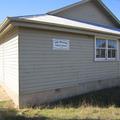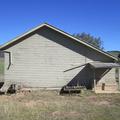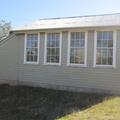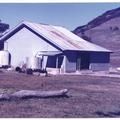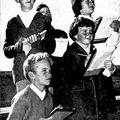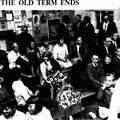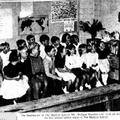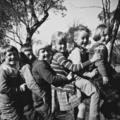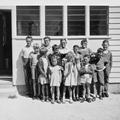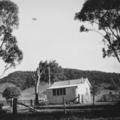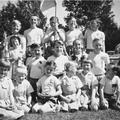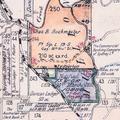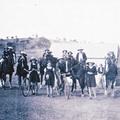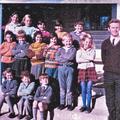< Early Canberra Government Schools
The Mullion [1959 - 1972]
The Mullion's early schools
The Mullion is a sheep and cattle grazing district midway between Yass and Canberra, accessed via Mountain Creek Road. The locality's pioneering squatter, John Ledger, claimed a vast run of 22,000 acres, originally called Stammer's Forest. It became known as Mullion Forest or The Mullion after John and his wife Mary (McFarlane) settled there in 1843. As the couple had eleven children, their extended family loomed large among graziers who raced to claim local acreages following the free selection Land Acts of 1861. This generation's grandchildren attended the district's first school.
In 1896, the local member for Queanbeyan, Edward O'Sullivan, secured approval for two schools to open half-weekly at Ledgerton, a Mullion property, and Uriarra, about 20km closer to present-day Canberra. 'Half-time' schools shared a state-appointed teacher who taught at two reasonably close localities. A Queanbeyan Age report of 11th July 1896 published the letter that O'Sullivan received, granting the schools: -
,'Sir, ...Referring to the formal application for the establishment of half-time schools at Uriarra and Ledgerton, I am directed to acquaint you that, having had under notice a report on the matter, the Minister for Public Instruction has decided to accede to the application on condition that the residents of both localities provide schoolrooms without cost to this Department in accordance with regulations 55 and 56 for half time schools, and that the regular attendance of children having more than 2 miles from the proposed sites will be maintained. When the school rooms are ready for occupation and the fact is notified to this Department, a teacher will be appointed.'
The two schools operated alternatively on two days one week and three the next. Attendance was not always guaranteed as the children would at times be needed to help with farm chores at home, particularly in shearing time. On days they were not at school, the children were kept busy ringbarking, digging out rabbits and fencing. The two schools met together for picnics and sports days.
Ledgerton School faced Mountain Creek Road about midway between Duncan Ledger's property 'The Mullion' and Charles Walker's property 'Ledgerton'. It was a timber slab construction, with a shingled roof and an earth floor covered by ant bed. Jointly with Uriarra, it opened on 1st January 1897, the two schools being taught by William Patrick Faulder, 27, the youngest son of Thomas Faulder of Yass. While boarding at 'Ledgerton' William courted Charles and Ann (Annie) Walker's daughter, Isabella Ann (also known as Annie), whom he married in January 1898. In October 1900 he was transferred to Kangiara Creek and Tangmangaroo, and went on to have a long and successful teaching career before retiring first to Bondi then Goulburn, where he died in 1947. An obituary said that William Faulder 'had one of those quiet charming and unassuming personalities which made him beloved of his scholars and held in the highest regard by the parents and his many friends'. (Picton Post, 6 March 1947)
The school's second teacher John Adams, who also boarded at 'Ledgerton', courted Annie's sister, Sarah Grace (known as Ruby). They married in December 1901. John continued at Ledgerton and Uriarra schools until July 1903 before being transferred. He too had a successful career in later years, rising to school inspector.
The third teacher, John T. Coddington, 17, had only just begun teaching in 1903. On probation, his annual salary was 72 pounds. Like his predecessors, John also courted a local girl: Charlotte Annie Webb, the daughter of William and Jane Webb (nee Ledger) of 'Fairlight', Uriarra. They were married in April 1906. Then, due to insufficient pupils, Uriarra and Ledgerton ceased as half-time schools in April 1907, Coddington being transferred to Burrumbuttock provisional school.
Uriarra reopened as a subsidised school 1907-10, closed 1911-19, opened again 1920-26, then closed again for ten years. It reopened in 1936 as a public school and remained open until 2001, when it closed permanently. Ledgerton School's subsequent history can only be glimpsed from a few newspaper items: Miss Ivy Dowling was appointed in April 1910; 'a lady teacher' was sought for Ledgerton subsidised school in 1911; and a Miss Jessie Worner farewelled by The Mullion community in 1913. As the Queanbeyan Age reported, Miss Worner's farewell was appreciatively celebrated: -
'A very pleasant and enjoyable afternoon was spent at the residence of Mr and Mrs D. Ledger's, " The Mullion" on Friday, August 22nd, the occasion being a farewell and presentation to Miss Jessie Worner who has for the last two years held the position of subsidised school teacher at Ledgerton. At eight o'clock dancing commenced and was kept merrily going until midnight when the company adjourned to the supper room.
... Mrs Ledger presented Miss Worner with a handsome, gold bracelet as a mark of esteem and appreciation from the parents and friends ... and Miss Ida Walker presented on behalf of the pupils, their teacher with a silver backed hair brush and comb, and little Miss Money Walker handed Miss Worner a beautiful bouquet of flowers. On rising to respond, Miss Worner was accorded quite an ovation. She said she was very sorry at having to leave so many warm friends and thanked them sincerely for their kindness that night and for the very handsome presents. After ample justice had been done to the very excellent supper all adjourned to the ballroom where dancing was kept up merrily till the sma' wee hours of the morning when all joined hands and sang "Auld Lang Syne". A move was then made homewards, everyone voting that they had spent a very jovial and enjoyable evening.'
(Trove: Queanbeyan Age, 29 August 1913)
It is likely that Ledgerton School followed Uriarra's pattern of being opened or closed according to fluctuating pupil numbers. The subsidised school scheme was first introduced in 1903 to assist isolated families who could not afford governesses. To obtain a subsidy of up to 25 pounds per annum, two or more families had to engage a private teacher and provide her with lodgings and a place to teach. If enrolments stabilised sufficiently, a subsidised school could become a public school as did Uriarra, but more often they had a brief life, especially after correspondence education began in 1916. The other alternatives for parents were to engage private tuition by governesses or to send their children to boarding schools. Exactly when Ledgerton School closed permanently is uncertain. Like other school buildings, it served as a polling booth for elections in the earlier 1900s, but had ceased being used as such by the 1920s.
The next Mullion school to open was a subsidised school on Gordon Ledger's 'Bonnieville' property, in the 1930s. Built by Gordon Ledger, it faced Mountain Creek Road at the northern end of The Mullion, not far from his property's homestead. Like Ledgerton, it had a succession of mostly female teachers. The following description of these two schools has been kindly provided by Stewart Ledger's daughter, Shirley Faulder, who went to Bonnieville school as a young girl: -
Shirley Faulder recalls the early Mullion schools
"The first Mullion school that my father used to talk about was the part-time school that operated in rotation with Uriarra School. The Mullion (Ledgerton) opened for two to three days a week then the following week it was the turn of the Uriarra School. I am unaware of any of the teacher's travelling details or accommodation details of their term of employment.
As far as I remember, there were three teachers at the school, namely Jack Adams, William Faulder and Mr Coddington. Jack and William married the daughters of Charles Frederick Walker and Annie Ledger respectively, both granddaughters of the first settler of The Mullion, John Ledger.
Mr Coddington had very strict and cruel teaching methods. I know this because the Newman boys took their little sister home one afternoon with swollen and bruised hands which developed into a ring of blood blisters. Mrs Newman was furious, she fronted up to Mr Coddington and verbally tore strips off him and threatened that if it ever happened again to any of the children she would report him to the local authorities. However as the story goes, the children had their own revenge. Mr Coddington used to sit on an old stump outside to watch the children at lunch. Pulling himself up with his two hands to land in the centre of the stump with a contented sigh.
One day he landed with a scream. The kids had sharpened a large homemade tack and had put it in a crack in the stump. When Mr Coddington came down with all his weight ... it was not a contented sigh he made. The kids all had smug faces.
I think between the closing of the old Mullion school in the early 1900s and the opening of Bonnieville subsidized school in the 1930s there were quite a few Governesses that worked with the children at private homesteads. Dad measured his schooldays in weeks rather than in years.
The Bonnieville school was built by Dad's brother Gordon Ledger, in the 1920s not even 250 metres North East from the Bonnieville homestead and was used to teach his own children by paid Governesses. By the mid thirties, Gordon had only one child in the school, finishing her last year. It was decided to open the school to the public. The school opened with 15 children.
The first teachers I remember were Miss Murray who stayed for a year then Miss Maher who stayed for one year. Poor old girls, I think it was all too much for them.
I can remember Miss Murray got very upset one afternoon when she was walking me home, which she did most days because she boarded at The Ranch. This particular day I tried to get the milking cows in so I didn't have to come back for them later. Miss Murray had words with Dad stating that I was still in her care until I got home from school and she felt that I should not be getting the cows in. I always felt she was more scared of the cows than she was really interested in my after school care.
Then came Miss Murdoch. Mum was asked to interview a new teacher in Epping Sydney because she was going to be up in Epping visiting her friend Mert Boon. Miss Murdoch was teaching at Carlingford boys home Parramatta. I can remember a young lady walking down the road to the house, beautifully dressed in a teal blue ensemble, with wisps of blond hair poking out from under a matching teal hat. I was desperate for her to be my teacher. Miss Murdoch became my dear friend and remained in my life until her passing in 2003.
Miss Murdoch, known as Kath to the adults, started the Mullion picnic in 1936, inviting the Cavan and Wee Jasper school children and families. We celebrated the Picnic's 80th Anniversary in 2016. Kath became a valued member of the community, playing tennis, cards and organising local competition cricket matches to raise money for the Yass Hospital. Not long after the war broke out, Kath gave up teaching and studied nursing at the Canberra Hospital at Acton ACT. When the war was over, Kath married Bobby Walker and became a permanent member of the Mullion, living at Fairbank.
I'm not sure of the order of teachers that came after Kath left. There was Miss Moyland, Miss Hellier, Miss Walsh and Miss Watling who stayed a couple of years. I think the Bonnieville School closed in the early 1940s.
The School was moved from Bonnieville to The Ranch by manpower. My three girls claimed it as a cubby house. Ben* and I were often invited in for afternoon tea. More often than not it was mud pies. I once shared the experience with a Shetland pony who was defiantly not impressed by being enticed into a small building by a piece of fresh bread. The school still stands today. It's only used for storage."
(*For Ben Faulder's recollection of his schooldays, see Wee Jasper School)
The later schools, 1951-1972
The next school was built by Leo Buckmaster of 'Roseville', Harold Walker of 'Ledgerton' and Fred Walker of 'Glenrock', in about 1951. Sited centrally in The Mullion on the community's recreational reserve, it was a small, well-built school with a glazed verandah, a flag pole, flower garden, water tank and pit-closet toilets. Its female teachers - locally appointed but subsidised by the state – conducted lessons prepared and marked by the Department of Education's Blackfriars Correspondence School, in Sydney. As elsewhere when a school of this kind was privately built and taught, it was called a 'provisional' school'. (The provisional school system ended in 1957)
Then in 1959 The Mullion School was granted regular public school status. The first state teacher appointed was Bob Denham in June 1959. Keith Amos succeeded him in 1960-61, followed by Anthony Avernell to September 1962, then Ernest Weston, 1962-63. Requests by 'Ernie' Weston and the parents succeeded in having a larger school approved in 1963. A site for it already existed just north of the old school: Portion 139, Parish of Umburra, dedicated for school purposes back in 1897. The new school was a recycled one from Kangiara Mines on the road to Booroowa, closed in 1958. It was transported to the Mullion, refurbished, and formally opened in mid 1963.
The Mullion School finally closed on 14th December 1972, the 7 pupils enrolled for 1973 deemed insufficient to keep the school operating. The school furniture was moved to a school in Yass for intellectual disabilities; the books and teaching aids sent to Murrumbateman School. The Canberra Times reported (15th December) that the keys to the building were handed to the P & C Association 'so that the building can be used for community activities until the department decides its future'. Arrangements were made for the remaining pupils to be transported to Uriarra School.
Memories of a former teacher-in-charge, 1960-61
Keith Amos began his teaching career at Captain's Flat in 1960. After three weeks he was transferred to The Mullion : -
"I didn't like my Captain's Flat appointment much. Single teachers shared the miners' quarters - tiny twin rooms with a steel locker for belongings. Pretty rough, hard-drinking all male company. And worse, in a medium-sized school I was placed on Kindergarten without any prior training. My first day was as traumatic for the children as it was for me – some were constantly crying and 3 or 4 tried to make a bolt for home.
I survived about 3 weeks, then had an unexpected reprieve from the Department: a married teacher from New Guinea needed placing and his wife was given my Kindergarten. A telegram told me that I was transferred to a 4th Class (one-teacher) school called 'The Mullion'. A problem arose in that the Principal couldn't tell me where it was, as there seemed to be no town or school of that name.
The only school with a similar name was Mullion Creek, near Orange, but no vacancy was listed there. I was also short of money, as no salary had arrived. So I phoned Head Office in Bridge St. Sydney, and was told to return there for a salary payment and directions on the school's whereabouts.
The Department's search found that the school had only just begun with a temporary teacher appointed in June 1959, having previously been a 'Provisional School' staffed by a parent – supervising lessons posted from the Correspondence School in Sydney. It was said to be somewhere out of Yass towards another small school at Wee Jasper. The arrangement was for me to ring the P&C president who would see that someone was there to meet me at Yass railway station.
All this worked to plan. A tall shearer named Alec Scorgie who had four children at school met me at the Station. We headed off along the unsealed Wee Jasper road to Taemas Bridge, then took a left fork into Mountain Creek Road and climbed through
pretty hilly country, arriving eventually at 'The Mullion' property, owned by David Ledger. This was about half way between Yass and Canberra.
It was arranged for me to board in a worker's cottage at the 'The Mullion' property, with Bert Wilson and his wife Margaret who had two daughters in the school. The arrangement was that I would pay 5 pounds board per week supplemented by 5/- per week from each of the other families who had children at the school. This totalled about 10 pounds per week –approx. $300 today. In return, Mrs Wilson prepared all meals and did my washing and room cleaning. The room was a garage attached to the house; not too flash, but a big improvement on the miners' quarters at Captain's Flat. More importantly, at 18 years old, I was solely in charge of my own school - about one km up the road.
The first step was getting to and from school. It suited the Wilsons for me to drive their two girls to & from school in their Austin sedan, as they had a ute for their use and my driving saved them time and petrol. Bert Wilson gave me a crash-driving course and an understanding Yass policeman gave me a licence - without leaving his desk from memory. I could then take over the driving from Margaret.
The school building was a neat little turn-out, about the size of a single garage with a small closed in verandah. It had been built by some of the parents adjacent to the local tennis courts and a community sportsground. It had a school fence, garden and flagpole. The classroom had space for only two rows of double desks – about ten desks all up. There were about two children in every grade from Kinder to Y6, and one Year 8 boy doing high school lessons by correspondence; a total enrolment of 17.
The pupils were the children of local property owners and their farm workers. The two Wilson girls were Elizabeth and Annette. Alec and Barbara Scorgie, who owned a heavily timbered block beyond the Mullion Hill had four children at school - from eldest down, Peter, Terry, Garry and Paul. Mervyn Apps, the secondary boy, was the son of a couple who managed Hyles's property, 'Horseshoe;' Gavin Walker was the son of Harold and Vera, the owners of 'Ledgerton'; Gavin's cousin, David Walker, the son of Fred and Marj, owners of 'Glenrock'; Cameron Archer, the son of Earle and Muriel, owners of 'Brooklyn'; Julie Buckmaster, the daughter of Leo and Margaret, owners of 'Roseville'; David and Rosemary Pate, the children of an Alf and Iris, owners of 'The Brook'; Cheryl Davis, the daughter of Harry and Phyllis, owners of 'Wombat'; Barry and Brian Smith, the sons of a couple who managed a property for Gordon Ledger; and Bronwyn Faulder, the daughter of Ben and Shirley, who owned 'The Ranch'.
A day's teaching -
Luckily Bob Denham, the temporary teacher one term before me, had started rolls and organised books and equipment etc. But even so I was mainly using instinct and imagination - having had no specialised training for infants or small school teaching. Like many others, I relied partly on memories about how I'd been taught in junior grades.
I prepared grade level worksheets for number, handwriting, language etc; taught at upper and lower division levels in lessons such social studies, natural science and music; and had shared whole school lessons where possible – say in art or sport. The children were easy to manage and waited patiently for me to help them individually. Also, I used the older children often to pair up and help the juniors: eg, guiding their reading.
Syllabus guidelines were simpler and much more practical than today's – every teacher owning a single volume NSW Curriculum we called a 'Blue Bible'. I made a lot of flash cards, charts etc, and Judy (my fiancée) gave support from Sydney: eg the educational store, 'Dominie', sold every imaginable resource, including canes. Also the school's P&C purchased extra resources I'd found and recommended. Writing up a term's program for all the grades was an arduous task; also upkeeping all the returns, such as daily travel allowances – 6d per pupil each day by car, 1/- per day by horse, etc.
The only contact with other schools was annually at the Yass District Athletics Carnival. And once we had an excursion, to an Education Week matinee put on by Yass Picture Theatre. I've never forgotten what a disaster that excursion was. Unknown to me, the theatre had chosen 'A Tale of Two Cities' – more suited to adults than children, and containing a guillotine scene. Also we arrived just after it had started, and collecting the smallest children from wandering off in all directions in the dark was like herding cats.
In summer we sweltered in such a small building without fans and a fairly low ceiling compared with most schools. My standard dress code at that time didn't help – a long-sleeved white shirt, long trousers and a tie. One of the Kindies asked me one day: 'Are you feeling cranky today Mr Amos?' - 'Not especially, why?' – 'Because whenever you're cranky, you wear a black tie, and you've got one on today'.
Winter went to the other extreme. In the coldest conditions my new VW Beetle - left outside - had an iced-up windscreen and was slow to start. I sometimes drove to school, looking through the bottom corner of the driver's windscreen, where the ice was thawed by a heater outlet. The first job at school was to stoke up a cylindrical stove at one end of the room. The closest children were the Kindies who tended to doze off in its warmth - which freed me of attending to them for a while! And if it was too cold for outside lunch, some children liked toasting their sandwiches on the stove.
One bleak winter's day in my first year, I've never forgotten. There was a so-called 'black frost' and biting wind all day. The Wilsons had dropped me off that morning, and in the afternoon rush I hadn't signalled wanting a lift home. Faced with having to
walk home, I fashioned a hood out of some thick Department-provided hand-towels, then headed off leaning into the wind. After a half-hour's walk home my face was numb with the cold.
.... The old Mullion School building was replaced in 1963 when the Education Department moved another disused small school onto a site nearby. It continued as a one-teacher school until permanently closed in 1972 - the building being then taken over for community use.
Looking back, my 'country service' was a great life experience. Though young and inexperienced at teaching, I was made warmly welcome in a beautiful rural setting. We've kept up friendships over the years and always feel a fond familiarity going back to The Mullion."
- With thanks to Keith Amos for permission to reproduce this extract from his memoir 'Small school teaching at The Mullion, out of Yass, 1960-1961', prepared for a Yass & District Historical Society conference, March 2012. The full article can be downloaded here.
Speech night at The Mullion, 1964 (Canberra Times, 17th December 1964)
"Headmaster Mr William Weatherstone beamed with pride last night on 17 children seated before him in an orderly row. There was not one absentee from The Mullion School's first speech night. Even better, the district's 40 parents and friends and a parliamentarian had come along in Land rovers, utilities and cars. 'When you know the people are behind you you're right', said Mr Weatherstone.
Mr Weatherstone – Bill to all the parents – is 21 and from Canberra. The Mullion, about 30 miles north-west of Canberra, is his first school. Mr Weatherstone, who has lived a term with each of three families in the area – the Davises, the Scorgies and the Eikenhouts – does not want to leave The Mullion, particularly after last night.
The children, from six families and looking more than merely healthy, sat in front of the schoolroom, with parents and friends on wooden benches behind. On the walls were some progress guides, a map of the world, a Gould League bird watching picture, some puppets, and copies of the school magazine The Post. 'The children edit it. I print it,' said Mr Weatherstone, and he showed me a sample: 'My clock goes bad so I gave it a kick and a boot and a smack. It went tick-tock, tick-tock, so it was all right.'
On a stage erected by the pupils was the guest of honour, Mr J R Fraser, Member for the ACT. Mr Weatherstone, the president of the Parents and Citizens' Association, Mr David Ledger, and the secretary, Mrs Harry Davis.
Mr Fraser was in his element. He told Tom Sawyer tales of his days as a one-teacher schoolteacher, of dust storms closing down his school, of snowstorms when locals put ice on top of the snow and slid around on galvanised iron. He told of teaching migrant children to speak English (and later their parents too), and of a school so crowded that some had to sit outside.
He told the children Sir Robert Menzies had attended a similar school at Jeparit, Victoria, and had become Prime Minister. He told them, too, of the responsibilities of citizenship.
And then The Mullion children presented a concert – Cinderella, folk songs, The First Christmas, an Indian dance, My Country, French songs, and Punch and Judy.
Book prizes were presented. Dux of the infant school was Keith Eikenhout, 8, and dux of the senior school was his 10-year-old brother Louis. They are sons of a Dutch grazier, and they aim to be farmers when schooldays end. Bronwyn Faulder, 9, a third-grade pupil, wants to be a nurse in Yass, Annette Wilson, 10, of fifth-grade, hopes to nurse in Goulburn. But most of the children want to make the land their living.
Among the original students 25 years ago at the old school (ie Bonnieville) still standing nearby were Mr David Ledger, now the owner of 'The Mullion' property on which the school stands (actually, it's on Faulders'), Mr Harry Davis on 'Wombat' property three miles away, and Mrs B Faulder, wife of the owner of 'The Ranch'. All have children at the new school, which was built (opened) about 18 months ago."
Seven pupils not enough to keep Mullion open (Canberra Times, 15th December 1972)
"The Mullion School broke up yesterday for the last time as the seven pupils who were enrolled for next year have been deemed insufficient to continue its existence. The school is about 25 miles from Canberra, beyond Uriarra Forest. There is no township, just a school and a few farms. The name 'The Mullion' came from the property over the road from the school.
The school's only teacher, Mr Ken Moxham, was expecting the school to be closed this year. Some families had left the area during first term, and the school numbers had dropped below the NSW Education Department's requirements. Mr Moxham has been at the school three years. Next year he will go to Sydney to teach. The school will not reopen until the number of children in the area rises.
The children will now go to the school at Uriarra Forest, 12 miles away. Mr Moxham thinks they may benefit from the change. With larger numbers they would have more competition and could enjoy organised sport.
The furniture has been moved to Yass to a school for the intellectually handicapped and the books and teaching aids have been taken to Murrumbateman School. The Department of Education has handed the keys of the building to the old P & c Association so the building can be used for community activities until the department decides its future."
Location Map
Related Photos
Teachers
- Denham, Mr Robert
06/1959 - 1960 - Amos, Mr Keith
02/1960 - 12/1961 - Avenell, Mr Anthony
01/1962 - 09/1962 - Weston, Mr Ernest ('Ernie')
09/1962 - 12/1963 - Weatherstone, Mr William ('Bill')
01/1964 - 12/1967 - Stanton, Mr Norman
01/1968 - 12/1968 - Haines, Mr Graham
01/1969 - 12/1969 - Moxham, Mr Kenneth
01/1970 - 12/1972
Related Documents
Maps - Parish Maps:
- Parish Map - Umburra (PDF 920.4 kb)
Published history:
- Teaching at The Mullion - Keith Amos (PDF 140.8 kb)
- Teaching at The Mullion - Photographs (PDF 2.6 Mb)
NSW Government schools from 1848
- The Mullion (external link)
< Early Canberra Government Schools
If you are able to assist our work of identifying, documenting, and celebrating the early bush schools of the Canberra region, please contact us or .


